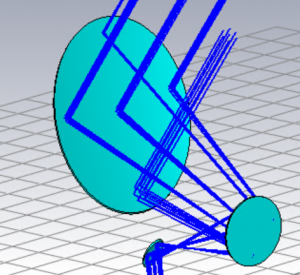Ultra-wide band width feed:

Currently, we are developing an ultra-wide band width feed to be used for the proposed PUMA experiment. In particular, this feed is being optimized to have a large band width (5.5 to 1) and a high SNR in power spectrum measurements. This is done by minimizing spillover, S11, and amplifier noise to keep the system temperature low. In addition, it has an “open” design in order to provide a narrow response in delay space. A narrow delay response minimizes the leakage of foregrounds into the 21cm signal. Cross coupling is also being considered in the design.
This design is currently being simulated using CST and refined using a numerical optimizer. The optimizer is given a lot of freedom to adjust the geometry of the antenna, hence the strange geometry seen in the picture here. Please email John Podczerwinski if you come up with a good name for this geometry.
The design of this feed draws a lot on the work done by Theunis Buekman, Sander Weinreb, Ahmed Akgiray, and the HERA team. Some good resources for these types of antennas can be found here:
Ahmed Akgiray’s Thesis: https://thesis.library.caltech.edu/7644/
Theunis Beukman’s Thesis: https://www.researchgate.net/publication/314897882_Modal-Based_Design_Techniques_for_Circular_Quadruple-Ridged_Flared_Horn_Antennas/link/58c71076458515478db8e178/download
Hera Delay Spec:
https://arxiv.org/pdf/2003.10733.pdf
Diffraction Analysis:

We are simulating the optical system of NASA’s EXCLAIM mission, a balloon-bourne microwave telescope. We are using CST to verify that the design meets performance goals, insure the optical system is properly understood, and contribute to sensitivity forecasts.
We have also been using POPPY to perform analogous Fourier optics calculations, see here.